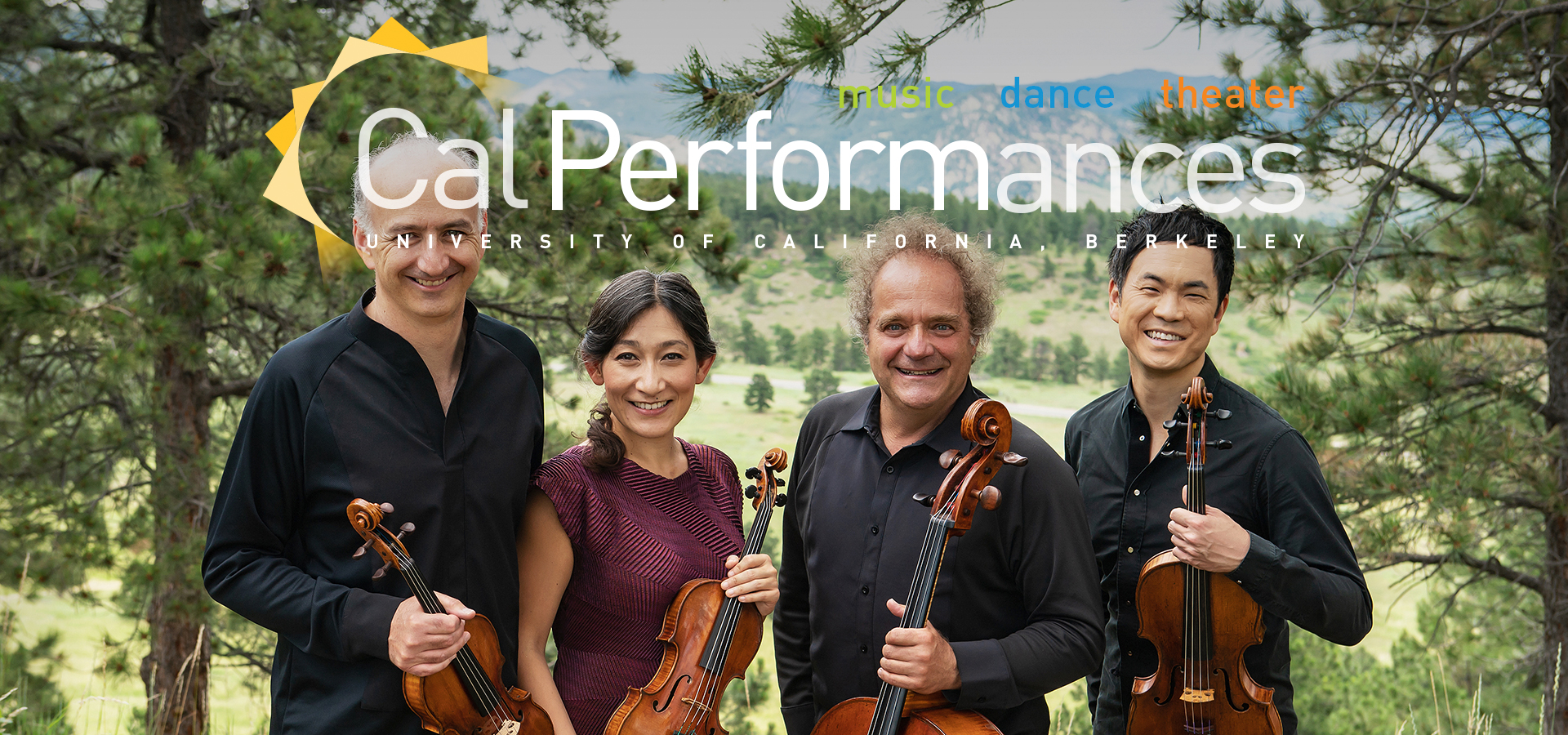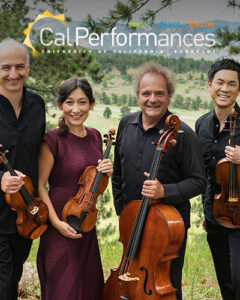Takács Quartet
Stephen Hough, piano
Sunday, February 20, 2022, 3pm
Hertz Hall
Takács Quartet
Edward Dusinberre, violin
Harumi Rhodes, violin
Richard O’Neill, viola
András Fejér, cello
The run time for this performance is approximately 1 hour and 40 minutes, including intermission but not including any encore.
The Takács Quartet appears by arrangement with Seldy Cramer Artists, and records for Hyperion and Decca/London Records.
The Takács Quartet is Quartet-in-Residence at the University of Colorado in Boulder; the members are Associate Artists at Wigmore Hall, London.
www.takacsquartet.com
This performance is made possible, in part, by Patron Sponsors Jeffrey MacKie-Mason and Janet Netz.
From the Executive and Artistic Director

Whenever I find myself walking across campus on a cool autumn or winter Sunday afternoon, on my way to a chamber music performance at Hertz Hall, I can’t help but think how lucky I am to work with the audiences, artists, and supporters we daily come into contact with at Cal Performances. Our chamber music audience, in particular—and we hear this over and over from our guest artists—stands out as a brilliant example of all that an audience can be—thoughtful, curious, enthusiastic, involved. These are rare occasions of musical fellowship for all concerned, gatherings of like-minded listeners and players who couldn’t be happier to spend a sunny Sunday afternoon at Hertz Hall with “old friends” like (as in today’s program) Haydn and Dvořák and newer ones like pianist/composer Stephen Hough. I can’t adequately thank the terrific Takács Quartet for bringing yet another insightful program to our campus. Over many memorable concerts, they have taught us—over and over again—volumes about the mysteries and wonders of great music. More than anything, I’m pleased that you could be here today to experience the finest in string quartet playing, music brought to us by one of the world’s most accomplished and beloved string ensembles.
I’d also to take a moment to make sure you know about another season highlight scheduled for next month (Mar 12), the West Coast premiere of Place, Ted Hearne and Saul Williams’ bold meditation on the topographies of gentrification and displacement. Another of this season’s Illuminations events, Place is a remarkable work, something I don’t think you’ll want to miss. (The recording for the New Amsterdam label captured the attention of the music world, earning two 2021 Grammy nominations—for Best Chamber Music/Small Ensemble Performance and Best Contemporary Classical Composition.)
February marks the time each year when Cal Performances’ programming shifts into high gear. From now through the beginning of May, the remainder of our 2021–22 season is packed with ambitious and adventurous programming. You won’t want to miss…
- sensational dance performances like Memphis Jookin’: The Show, featuring Lil Buck (Feb 25–26); The Joffrey Ballet (Mar 4–6); and the Alvin Ailey American Dance Theater (Mar 29 – Apr 3)
- the peerless London Symphony Orchestra (Mar 20), appearing under the direction of superstar conductor Sir Simon Rattle in a program of orchestral masterworks
- early-music masters Jordi Savall and Le Concert des Nations (Mar 4) performing selections from the classic 1991 film soundtrack to Alain Corneau’s Tous les matins du monde
- the renowned English Baroque Soloists with conductor Sir John Eliot Gardiner in a transfixing program of works by Mozart and Haydn (Apr 10)
- pianist extraordinaire Mitsuko Uchida playing and directing Mozart with the Mahler Chamber Orchestra (Mar 27)
- our 2021–22 artist-in-residence Angélique Kidjo in her brand new music-theater piece Yemandja (a highly anticipated Cal Performances co-commission and Illuminations event, Apr 23).
Fasten your seatbelts; we have all of this—plus much more—in store for you!
We’re very proud of our new and updated winter brochure and know that a few minutes spent reviewing our schedule—in print or online—will reveal a wealth of options for your calendar; now is the perfect time to guarantee that you have the best seats for all the events you plan to attend.
I know you join us in looking forward to what lies ahead, to coming together once again to
encounter the life-changing experiences that only the live performing arts deliver. We can’t wait to share it all with you during the coming months.
Jeremy Geffen
Executive and Artistic Director, Cal Performances
 Whenever I find myself walking across campus on a cool autumn or winter Sunday afternoon, on my way to a chamber music performance at Hertz Hall, I can’t help but think how lucky I am to work with the audiences, artists, and supporters we daily come into contact with at Cal Performances. Our chamber music audience, in particular—and we hear this over and over from our guest artists—stands out as a brilliant example of all that an audience can be—thoughtful, curious, enthusiastic, involved. These are rare occasions of musical fellowship for all concerned, gatherings of like-minded listeners and players who couldn’t be happier to spend a sunny Sunday afternoon at Hertz Hall with “old friends” like (as in today’s program) Haydn and Dvořák and newer ones like pianist/composer Stephen Hough. I can’t adequately thank the terrific Takács Quartet for bringing yet another insightful program to our campus. Over many memorable concerts, they have taught us—over and over again—volumes about the mysteries and wonders of great music. More than anything, I’m pleased that you could be here today to experience the finest in string quartet playing, music brought to us by one of the world’s most accomplished and beloved string ensembles.
Whenever I find myself walking across campus on a cool autumn or winter Sunday afternoon, on my way to a chamber music performance at Hertz Hall, I can’t help but think how lucky I am to work with the audiences, artists, and supporters we daily come into contact with at Cal Performances. Our chamber music audience, in particular—and we hear this over and over from our guest artists—stands out as a brilliant example of all that an audience can be—thoughtful, curious, enthusiastic, involved. These are rare occasions of musical fellowship for all concerned, gatherings of like-minded listeners and players who couldn’t be happier to spend a sunny Sunday afternoon at Hertz Hall with “old friends” like (as in today’s program) Haydn and Dvořák and newer ones like pianist/composer Stephen Hough. I can’t adequately thank the terrific Takács Quartet for bringing yet another insightful program to our campus. Over many memorable concerts, they have taught us—over and over again—volumes about the mysteries and wonders of great music. More than anything, I’m pleased that you could be here today to experience the finest in string quartet playing, music brought to us by one of the world’s most accomplished and beloved string ensembles.
I’d also to take a moment to make sure you know about another season highlight scheduled for next month (Mar 12), the West Coast premiere of Place, Ted Hearne and Saul Williams’ bold meditation on the topographies of gentrification and displacement. Another of this season’s Illuminations events, Place is a remarkable work, something I don’t think you’ll want to miss. (The recording for the New Amsterdam label captured the attention of the music world, earning two 2021 Grammy nominations—for Best Chamber Music/Small Ensemble Performance and Best Contemporary Classical Composition.)
February marks the time each year when Cal Performances’ programming shifts into high gear. From now through the beginning of May, the remainder of our 2021–22 season is packed with ambitious and adventurous programming. You won’t want to miss…
- sensational dance performances like Memphis Jookin’: The Show, featuring Lil Buck (Feb 25–26); The Joffrey Ballet (Mar 4–6); and the Alvin Ailey American Dance Theater (Mar 29 – Apr 3)
- the peerless London Symphony Orchestra (Mar 20), appearing under the direction of superstar conductor Sir Simon Rattle in a program of orchestral masterworks
- early-music masters Jordi Savall and Le Concert des Nations (Mar 4) performing selections from the classic 1991 film soundtrack to Alain Corneau’s Tous les matins du monde
- the renowned English Baroque Soloists with conductor Sir John Eliot Gardiner in a transfixing program of works by Mozart and Haydn (Apr 10)
- pianist extraordinaire Mitsuko Uchida playing and directing Mozart with the Mahler Chamber Orchestra (Mar 27)
- our 2021–22 artist-in-residence Angélique Kidjo in her brand new music-theater piece Yemandja (a highly anticipated Cal Performances co-commission and Illuminations event, Apr 23).
Fasten your seatbelts; we have all of this—plus much more—in store for you!
We’re very proud of our new and updated winter brochure and know that a few minutes spent reviewing our schedule—in print or online—will reveal a wealth of options for your calendar; now is the perfect time to guarantee that you have the best seats for all the events you plan to attend.
I know you join us in looking forward to what lies ahead, to coming together once again to
encounter the life-changing experiences that only the live performing arts deliver. We can’t wait to share it all with you during the coming months.
Jeremy Geffen
Executive and Artistic Director, Cal Performances





